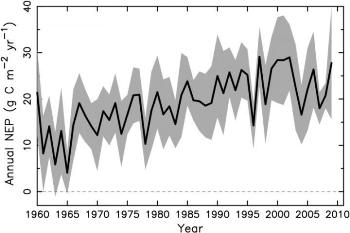Jul 30 2015
In a new assessment of nine state-of-the-art climate model simulations provided by major international modeling centers, Michael Rawlins at the University of Massachusetts Amherst and colleagues found broad disagreement in the amount of atmospheric carbon dioxide (CO2) annually sequestered in tundra and boreal ecosystems of Northern Eurasia, a vast, understudied region of the world.
 Annual net ecosystem productivity, (NEP, in grams of carbon per square meter per year) across the study region as an average across the nine climate models. Standard error range is shown in gray. Annual NEP, which closely tracks the net CO2 sink, shows an increase through the first four decades, and remains relatively stable since 2000.Cerdit:UMass Amherst
Annual net ecosystem productivity, (NEP, in grams of carbon per square meter per year) across the study region as an average across the nine climate models. Standard error range is shown in gray. Annual NEP, which closely tracks the net CO2 sink, shows an increase through the first four decades, and remains relatively stable since 2000.Cerdit:UMass Amherst
Rawlins also identified a trend among the nine models that shows the region's land carbon sink has been strengthening in recent decades, drawing in more carbon than expected, driven by increases in carbon uptake from plant growth that outweigh respiration increases. But lately, it shows signs of weakening.
"As a group, the models tend to overestimate carbon emissions from land, particularly in autumn," he says. "They generally underestimate the present-day carbon sink, in our view. So there is good news, in that the region is likely storing more of the carbon being emitted by human activities than the models depict. But the lack of agreement across the models is a concern."
He adds, "Given the wide range in sink strength across the models, we are recommending that decision makers not rely on a single model for predicting what the future of the Arctic may be. This could lead to a very biased assessment." Findings appear in the current issue of Biogeosciences.
The lack of agreement "is not for a lack of effort on the part of modeling groups," Rawlins points out, but rather from a lack of available data to improve understanding of key processes. Northern Eurasia is critically undersampled, with much less field study than other parts of the Arctic.
For this model intercomparison supported by NASA, Rawlins and the team examined simulations from nine land models participating in the Model-Integration Working Group of the Permafrost Carbon Network (PCN). Group members from each center conducted retrospective simulations from 1960 to 2009, producing current best estimates of the flow of CO2 between the land and atmosphere. They compared the model data with satellite and land-based measurements to establish model credibility.
Rawlins and colleagues also found that residence time of carbon in soils is decreasing in response to warming temperatures that enhance both carbon uptake from plant growth and carbon emissions from soil litter decomposition. "In essence, carbon is moving through northern ecosystems at a faster rate," he points out.
This study and others from the PCN are helping modelers to refine representation of carbon fluxes and storages across permafrost regions, Rawlins says. The best climate models constantly evolve, adding multiple interacting variables over time. However, the simulation of terrestrial ecosystem processes is currently inadequate. "Models do a good job at simulating some elements of the climate system, but they disagree on key aspects of the land-atmosphere CO2 exchange, and in particular the amount of carbon being sequestered," he explains.
Statistically speaking, the range in model estimates of net productivity, which closely approximates the net CO2 sink, is twice the multi-model average. "This speaks to the level of uncertainty in sink strength," the climate scientist says.
Rawlins and the team point out the need for new field data on vegetation and soil characteristics for model parametrization and validation. "Comparisons with the few available tower-based measurements suggest that the models tend to overestimate land carbon emissions in spring and autumn. However, the lack of data across this large area limits our confidence in this bias. There is an obvious need for establishment of more research sites. Additionally, soil measurements at new locations must be made at several depths, and during autumn, winter and spring," he notes.
They also provide additional recommendations to improve model simulations of Arctic carbon cycle process, writing that investments must be made to develop new benchmarking datasets from measurements and remote-sensing observations and to support coordinated model intercomparison studies using standardized driving variables.
Source: http://www.umass.edu